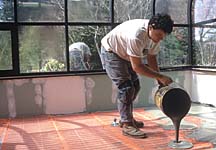So it was with an inheritance from her mother that Hein decided to give to others what she and her family desperately wanted at that time — a place in nature to heal and connect, away from the turmoil and drama of cancer treatments, the poking and prodding, harried appointments, and a home life interrupted.
Hein bought a four-bedroom house on Orcas Island, 20 miles off the coast of northwest Washington, and transformed it into the place of her dreams, with 25 acres of flowering gardens, ponds, a flowing stream crossed by an arched bridge, and trails winding through the woods with sheltered sitting areas. She calls it Sadh Desha (pronounced “Sod-Daa-Sha”), a Sanskrit term meaning “a place to reclaim that which is divine in us, that which intends us to heal nature, heal ourselves, serve, give, and rejoice.”
Now, seven years after her mother’s death, Sadh Desha (www.sadhdesha.com) is Hein’s free gift to others who live with the disease of cancer. The complex is preparing for its third season as a retreat for those with cancer and their families and friends. As a yoga instructor, Hein knows the many benefits of finding a quiet place for rest and meditation. Yoga lessons softly punctuate the experience for guests. And to make them as comfortable as possible in the new yoga studio, Hein financed the remodeling of a garage on the property, turning it into a yoga studio complete with an extensive radiant heat system manufactured by Watts Radiant, based in Springfield, Mo.

Installing Radiant Heat
John Miller, a new construction and remodeling contractor who lives on the island, was chosen by Hein to do the job. One of her first questions had to do with bringing warmth into a building that previously had no heat. “She wanted an option to forced air,” said Miller. “Considering the building’s planned use as a yoga studio, radiant heat was the perfect match.”“Where better than to put the heat into the floor, especially considering that it’s the surface we spend all of our time on when we’re in the yoga studio,” said Hein. “A cold floor can be quite uncomfortable and distracting, especially for patients who are sensitive to this.” Between chemotherapy treatments, it’s common for patients to struggle with poor blood circulation.
Electric radiant was chosen over hydronic heat because of the expense. The building didn’t have a boiler or other source for hot water.
“We selected the Suntouch electric mat system because of its reputation and ease of installation,” said Miller. “The radiant system was promptly designed, and the heat load was accurately assessed by the manufacturer.”
The job called for 560 square feet of radiant heat covered by an engineered beechwood floor manufactured in Switzerland.
Installation of the 220-V system was a three-day job for Miller and one assistant. “Not bad for first-time installers,” said Miller. “Much of the time was spent mixing and applying a thin, protective coat of cement over the wire mat.” The cement helps to spread and retain the heat, and gives the wood flooring a solid surface on which to rest.
“We had some questions along the way, and even a glitch or two, but we found that the technical support professionals were easily accessible and very helpful,” said Miller.
Watts Radiant engineer Tony Ledford, who designed the Suntouch system for the yoga studio, said that a total of four equally sized mats were used to ensure balanced heat. “The system provides up to 40 Btu of heat [drawing 12 watts] per square foot,” explained Ledford. “There are also two, seven-day a.m./p.m. programmable thermostats, each of which has one 24-by-60-inch mat, and one 24-by-80-inch mat. Each mat is hard-wired to a T-stat. The system takes just 30 minutes to heat up.”

Warm Surroundings
“The radiant heat is so well suited to yoga,” said Hein. “People have commented about how cozy they feel. It’s especially important for yoga to be practiced in a comfortable setting.”Some experts believe yoga can delay or reduce the progression of disease. It has also been reported that yoga helps to alleviate side effects of some treatment drugs. Yoga also offers a form of exercise that can be adapted to one’s level of energy and stamina, something positive for patients to do to help counteract feelings of depression, helplessness, and despair.
Sadh Desha is available to cancer patients and their loved ones free of charge on a limited basis (up to five weeks). To finance the retreats for cancer patients, Hein rents Sadh Desha separately from the cancer retreats. Included in the price for individual, family, or group retreats are three 90-minute yoga classes, use of a large, fully stocked kitchen, relaxing in the spa, and access to the entire 25-acre property. Massage, acupuncture, therapeutic touch, and additional group or individual yoga classes are also available.
A recent visitor of Sadh Desha summed up the experience this way: “When I walk under the cedar shake roof, through the wood gate and onto the garden path, I feel a letting go, like nothing bad can happen here. I like to sit on the edge of the small dock extending into one of Dee’s ponds, dip my feet in the water, and sometimes even my body, or just sit in the wood chairs on the deck of the house and watch the beauty of nothing happening. Here, we all heal.”
Publication date: 10/13/2003

Report Abusive Comment